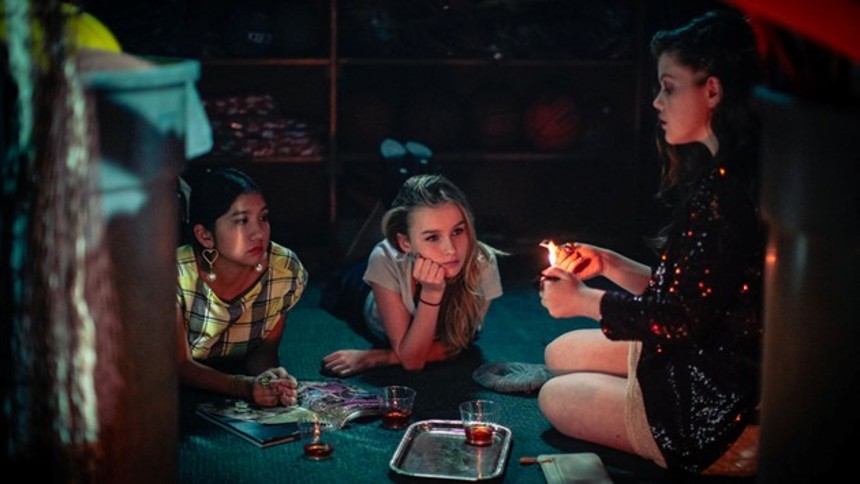Review: THE SISTERHOOD OF NIGHT Reveals The Secret Lives Of Teenage Girls

By now, anyone who regularly reads about the movie business is well aware of the dismal statistics concerning the representation of women - or more pertinently, the lack thereof - as directors, writers, and just about every other creative capacity in the business. No need to reiterate the actual numbers here; a quick Google search will point you to tons of think pieces offering the details.
With that, I submit for your approval The Sisterhood of Night, a film whose main creative forces are two women - director Caryn Waechter and screenwriter Marilyn Fu - as a fine example of the rich and poignant nuances that a strong, authentic, and artistically expressed female-centered perspective can bring to bear on seemingly familiar material. In the case of this film, it's the small-town high school and its attendant emotional and societal maelstrom of cliques, gossip, and other anxieties of adolescence. Waechter and Fu's take on all this proves to be quietly haunting and ultimately emotionally powerful, making The Sisterhood of Night an impressive feature debut for them both.
Adapted from Steven Millhauser's 1994 short story (a brilliant gem in its own right), The Sisterhood of Night has been expanded and updated to reflect the way teenagers live now, specifically how social media has radically transformed their relations with one another and their own self-images. Just as in the original short story, the film centers on a modern-day version of the Salem witch trials. In this story, however, the heretical crimes that the girls at its center are accused of don't involve religion, but rather the radical act of opting out of the regime of social media oversharing demanded of their age set, and refusing to let this define their self-worth. Going analog and off the grid in this way results in serious consequences for everyone involved.
Leading the charge in this mini-movement is Mary (Georgie Henley), who, finally fed up with the system of cliques at her school, a system buttressed and exacerbated by social media, suddenly removes herself from Facebook. She turns to a much older form of media to express her thoughts and feelings: setting pen to paper to start a diary.
Along with her close friends Catherine (Willa Cuthrell) and Lavinia (Olivia De Jonge), Mary starts a secret society for girls called "The Sisterhood of Night." The central mystery upon which the film hinges concerns the exact nature of this society, many details of which are presented ambiguously in the early scenes. There is one intriguing scene in which Mary, Catherine, and Lavinia gather in a circle for an initiation ceremony. At one point, the girls each write a deeply held secret on a piece of paper, after which the paper is burned. (Incidentally, this method of secret keeping is paralleled with one in another film, Wong Kar-wai's In the Mood for Love, cannily referenced by Catherine in a later scene.)
Thereafter, the girls begin recruiting others to join the group. New members are given pieces of paper with pictorial code for the meeting place for their initiation. Once accepted, all members are sworn to secrecy. This secrecy engenders rampant speculation among students and the population at large once word spreads about the group.
The real trouble for the Sisterhood arrives in the form of Emily (Kara Hayward), the school's main gossipmonger and Mary's nemesis. Emily, unlike the Sisterhood, lives and breathes social media, maintaining a blog where she broadcasts the latest gossip, anxiously monitoring her follower stats and comments left on the site. Emily, needless to say, isn't chosen for the Sisterhood, yet she manages to fake her way to their meeting place. Afterward, Emily spins a wild tale of the activities that supposedly occurred there, involving sex acts and devil worship.
This sets into motion a series of events that reverberate well beyond the town's environs, with Emily's blog postings sparking scandalized gossip in the school, panicked parents, and media frenzy. The Sisterhood's resolute silence only fuels the fire. Eventually, this leads to a tragic event that illustrates the cruelty facilitated by the social media abhorred by the Sisterhood.
Although there are intimations of horror movie tropes - spooky nighttime scenes in the woods, bonfires, talk of witches - The Sisterhood of Night is not a horror film. In fact, there isn't really a genre in which the film comfortably fits; immersing us deeply in its characters' stories and vividly conveying what it looks and feels like to be a teenage girl are the qualities that are most at the fore. While this results in a film that may be harder to market, it is nevertheless one that resonates deeply with the viewer.
The film concludes on a moving, simultaneously joyous and poignant scene which is both a tribute to a fallen comrade and the culmination of the Sisterhood (and the film's) utopian vision of a safe space young women have carved out for themselves. Here, they can express their hopes, fears, and joys freely and without judgment, while retaining a private space of mystery and wonder free from the prying, controlling, and narrowly defining eyes of the public.
The Sisterhood of Night opens in theaters and will be available on VOD on April 10.

Do you feel this content is inappropriate or infringes upon your rights? Click here to report it, or see our DMCA policy.






